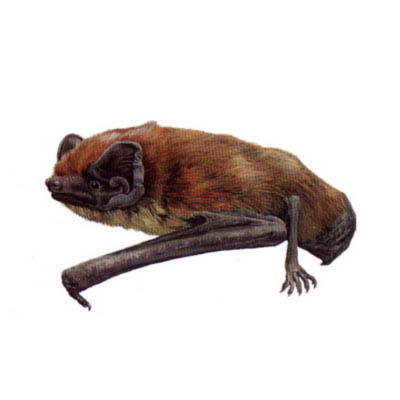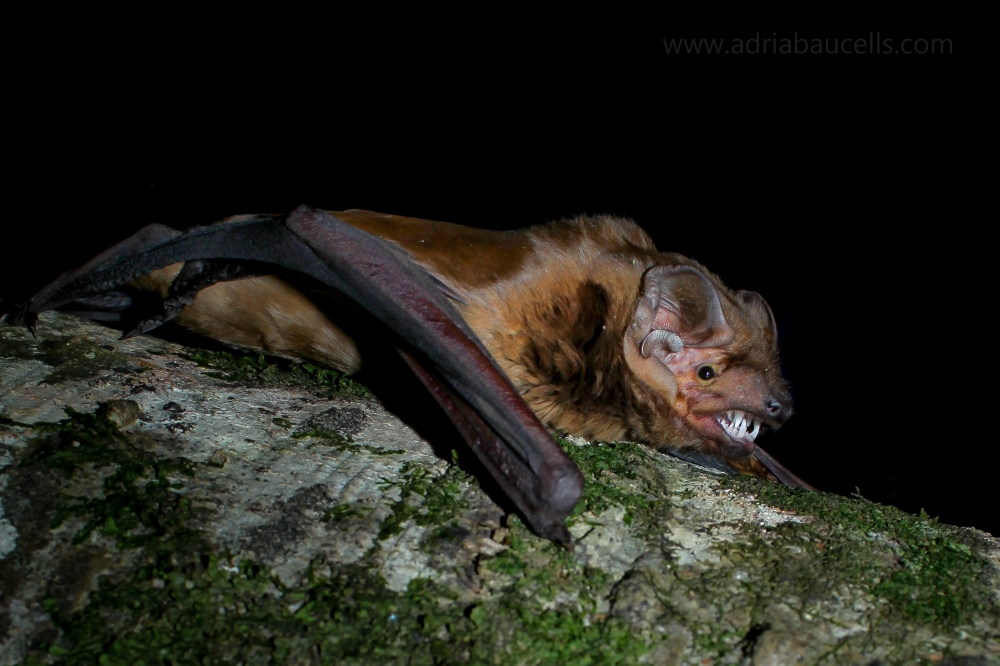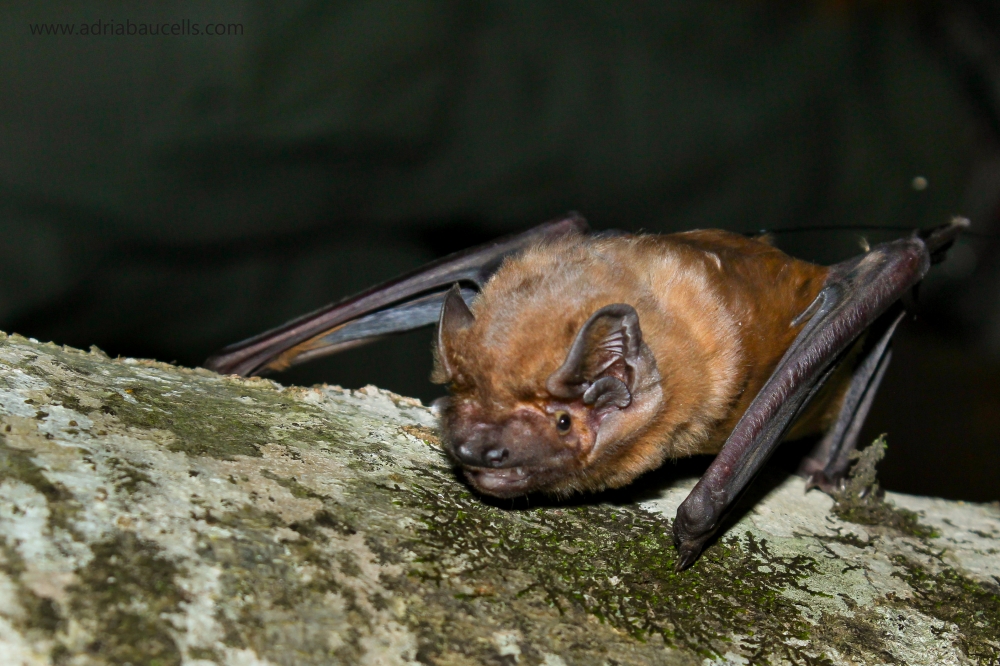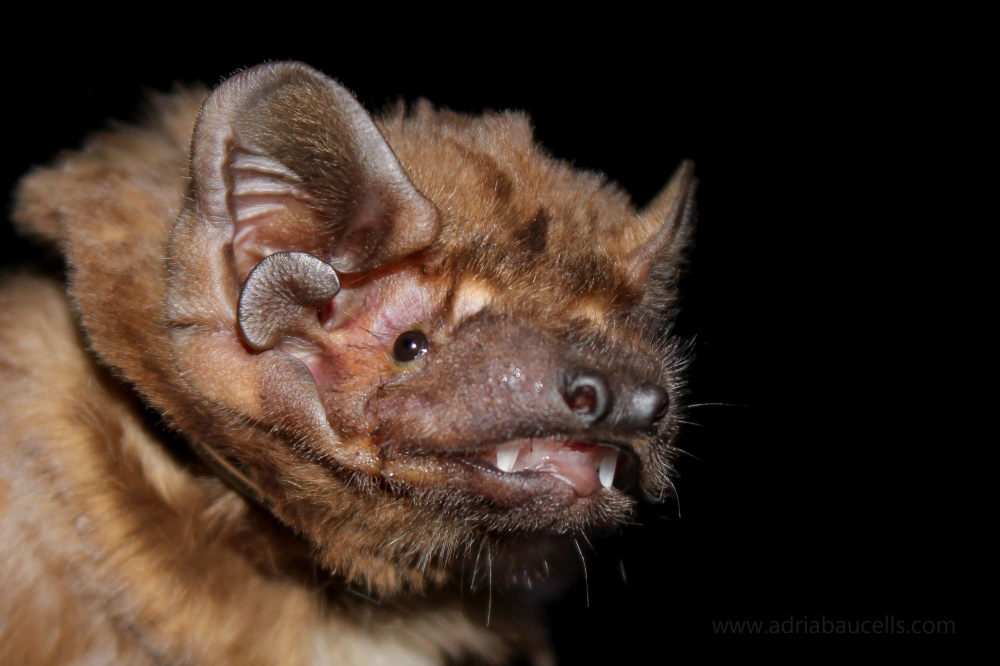Greater noctule bat

Nyctalus lasiopterus (Schreber, 1780)
Vespertilionidae
Vulnerable
| Other names | |
|---|---|
| Catalan | Nòctul gegant |
| Spanish | Nóctulo grande |
| English | Greater noctule bat |
| French | Grande Noctule |
| Basque | Gau-saguzar handiaren |
| Galician | Nóctulo grande |
Description
The largest bat in Europe, with a total head and body length ranging from 78 to 104 mm, a forearm of 60 to 70 mm, a wingspan of 410 to 460 mm, a tail of 55 to 66 mm, and a weight ranging from 35 to 60 g. It is very robust and large, with a broad muzzle, a large head, and relatively short (21 to 26 mm), rounded ears. Like other noctules, the tragus is short and wide, kidney or mushroom-shaped. The skin is dark brown, and the fur is dense, relatively long, and unicoloured, with the back being reddish-brown or dark brown and the belly only slightly lighter. Males can raise the hair behind the nape like a kind of mane. The wings are very long and narrow, and the inner wing is quite hairy between the body and the fifth digit and up to the elbow.
Unmistakable due to its size.
Fotografies
Distribution
Its distribution is primarily around Mediterranean and Eastern Europe, although the distribution is extremely fragmented and often consists of isolated sightings. Population densities are usually very low. It was previously believed to have a continuous distribution extending to the Russian taiga, passing through the Urals, the Caucasus, Iran, and Kazakhstan. However, the last sighting in Ukraine dated back to 1955 until its rediscovery with a single sighting in 2009.
Roosts and phenology
Most roosts are found in abandoned woodpecker holes in deciduous forests of beeches, oaks, plane trees, and poplars, as well as in firs. The known breeding colonies are very few and are found in Seville, Jerez, Cadiz, and Doñana (in Spain), southern France, Tuscany (Italy), northern Greece, and the Mátra Mountains (Hungary). In Seville, they shelter in plane trees, at a height of 4-10 meters, as well as under palm fronds. Solitary individuals also occupy bat boxes, under roofs, or in crevices in large caves. In Spain, breeding colonies can reach 80 individuals, all females. In Ukraine and Russia, colonies are usually 2 to 10 animals, and they often share them with the noctule bats (Nyctalus noctula), Leisler's bats (Nyctalus leisleri), Nathusius' pipistrelles (Pipistrellus nathusii), and common pipistrelles (Pipistrellus pipistrellus). Births start in late May and can last until early June, while lactation ends in early August. Females usually return to their natal breeding colony, while males form isolated groups.
The absence of females in the summer in Greece and southern Iberia, and of individuals of both sexes (but especially females) in the northern part of their distribution in winter, seems to indicate that it is a migratory species. Some individuals can reach northern France, the Netherlands, southern Germany, and Poland. This species currently holds the record for the longest migration of a bat, with an individual tracked with GPS having covered a distance of 2,515 km from Moscow to northern Italy. A sighting of an individual over 43 km from the coast suggests that some populations migrate across the Black Sea.
Habitat and diet
Species found in deciduous or mixed forests and old coniferous forests in mountainous areas. It can be found between 900 and 1,600 m above sea level. In the Mediterranean area, especially in Spain, it also occupies parks with large plane trees. It appears that they need large trees with large trunks, and therefore, mature forests. Besides open areas in the midst of these forests, marshes and wetlands are important hunting grounds.
Its diet consists of large insects such as moths, beetles, and dung beetles, which are captured in open areas during flight. In Italy, Spain, and Greece, the presence of bird remains in their droppings has been described. Between March-May and between August-November, bird remains such as robins (Erithacus rubecula), tits (Paridae family), and warblers (Phylloscopus sp.) have been found in 70% of the droppings of this species. It is unknown whether it catches these birds in flight during their migrations or if it captures them in trees when they rest. The flight is fast and direct, sometimes at great heights (estimates of several hundred meters have been made by observing them from the ground).
Echolocation
Long, up to 35 ms, mainly constant frequency (QCF) very intense calls with peak frequencies of about 13-16 kHz. However, more modulated calls (FM-QCF) in more confined spaces may have frequencies that can reach 16-22 kHz. In open spaces, it tends to alternate between two calls with a 2 kHz difference between them. The calls are clearly audible, similar to those of the European free-tailed bat (Tadarida teniotis), so both species are included in the Tadarida teniotis/Nyctalus lasiopterus phonic group.
Status
According to the IUCN Red List, this species is considered Vulnerable, with a negative population trend. This species is protected by national laws in various countries, such as the Eurobats Agreement, the Bern Convention, and the European Habitat and Species Directive. Currently, it is assumed that the population is experiencing a widespread decline in the number of individuals, mainly due to deforestation, especially the destruction of mature and old-growth forests. In particular, populations in Sevilla are threatened by competition with the Rose-ringed Parakeet (Psittacula krameri), an aggressive invasive species that competes with the greater noctule for tree cavities.


